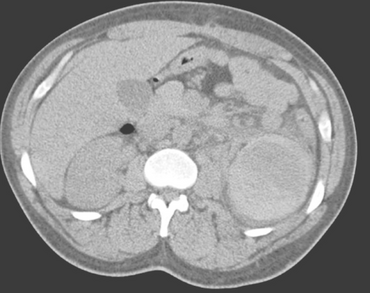Factor X deficiency
| Factor X deficiency | |
|---|---|
| Other names: Stuart-Prower factor deficiency | |
 | |
| Factor X deficiency is inherited in an autosomal recessive manner | |
Factor X deficiency (X as Roman numeral ten) is a bleeding disorder characterized by a lack in the production of factor X (FX), an enzyme protein that causes blood to clot in the coagulation cascade. Produced in the liver FX when activated cleaves prothrombin to generate thrombin in the intrinsic pathway of coagulation. This process is vitamin K dependent and enhanced by activated factor V.
The condition may be inherited or, more commonly, acquired.
Signs and symptoms
Symptoms may differ greatly, as apparently modifiers control to some degree the amount of FX that is produced. Some affected individuals have few or no symptoms while others may experience life-threatening bleeding. Typically this bleeding disorder manifests itself as a tendency to easy bruising, nose bleeding, heavy and prolonged menstruation and bleeding during pregnancy and childbirth, and excessive bleeding after dental or surgical interventions. Newborns may bleed in the head, from the umbilicus, or excessively after circumcision. Other bleeding can be encountered in muscles or joints, brain, gut, or urine[1][2]
While in congenital disease symptoms may be present at birth or show up later, in patients with acquired FX deficiency symptoms typically show up in later life.[citation needed]
Causes
Inherited or congenital FX deficiency is passed on by autosomal recessive inheritance.[2] A person needs to inherit a defective gene from both parents. People who have only one defective gene usually do not exhibit the disease, but can pass the gene on to half their offspring. Different genetic mutations have been described.[citation needed]
In persons with congenital FX deficiency the condition is lifelong. People affected should alert other family members as they may also have the condition or carry the gene. In the general population the condition affects about 1 in 1 million people.[2] However, the prevalence may be higher as not all individuals may express the disease and be diagnosed.[citation needed]
In the acquired form of FX deficiency an insufficient amount of factor X is produced by the liver due to liver disease, vitamin K deficiency, buildup of abnormal proteins in organs (amyloidosis) or certain medications (i.e. warfarin).[1] In amyloidosis FX deficiency develops as FX and other coagulation factors are absorbed by amyloid fibrils.[3]
Diagnosis

Blood tests are needed to differentiate FX deficiency from other bleeding disorders.[1] Typical are normal thrombin time, prolonged prothrombin time (PT) and prolonged partial thromboplastin time(PTT).[1] FX antigen and its coagulant activity can be used to classify the severity of the condition:[4]
- Type I has low levels of FX antigen and activity.
- Type II has low coagulant activity but normal or borderline FX antigen levels.
The FX (F10) gene is found on chromosome 13q34.[2] Heterogeneous mutations have been described in FX deficient patients.
Treatment
There are several treatments available for bleeding due to factor X deficiency. A specific FX concentrate was not available as of 2009[update].[4]
- Prothrombin complex concentrate (PCC) supplies FX with a risk of thrombosis.
- Fresh frozen plasma (FFP): This is relatively inexpensive and readily available. While effective this treatment carries a risk of blood-borne viruses and fluid overload.
- If vitamin K levels are low, vitamin K can be supplied orally or parenterally.
Treatment of FX deficiency in amyloidosis may be more complex and involve surgery (splenectomy) and chemotherapy.[3]
History
The condition was described independently in the 1950s. Telfer and coworkers described a female patient named Prower in 1956 and Hougie and coworker described a male patient named Stuart in 1957. When experiments showed that serum from these two patients lacked the same factor, these two patients were the first people identified with FX deficiency and the factor was called Stuart-Prower factor, later factor X. [5]
References
- ↑ 1.0 1.1 1.2 1.3 "Factor X deficiency?". Medline Plus. January 22, 2015. Archived from the original on February 20, 2017. Retrieved February 18, 2017.
- ↑ 2.0 2.1 2.2 2.3 "factor X deficiency". Genetics Home Reference. February 14, 2017. Archived from the original on March 24, 2017. Retrieved February 18, 2017.
- ↑ 3.0 3.1 Veneri D, Giuffrida AC, Bonalumi A, Calabria S, Gandini G, Ambrosetti A, Minuz P (November 2016). "Use of prothrombin complex concentrate for prophylaxis of bleeding in acquired factor X deficiency associated with light-chain amyloidosis". Blood Transfus. 14 (6): 585–586. doi:10.2450/2016.0335-15. PMC 5111391. PMID 27416580.
- ↑ 4.0 4.1 M Menegatti, F Peyvandi (2009). "Factor X Deficiency". Semin Thromb Hemost. 35 (4): 407–415. doi:10.1055/s-0029-1225763. PMID 19598069.
- ↑ RA Schwartz (June 17, 2016). "Factor X deficiency". Medscape. Archived from the original on March 17, 2017. Retrieved February 18, 2017.
External links
| Classification | |
|---|---|
| External resources |
- Pages with script errors
- All articles with unsourced statements
- Articles with unsourced statements from July 2020
- Articles with invalid date parameter in template
- Articles with unsourced statements from November 2021
- Articles containing potentially dated statements from 2009
- All articles containing potentially dated statements
- Bleeding
- Coagulopathies